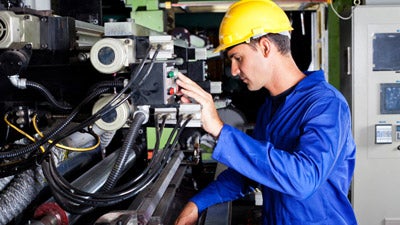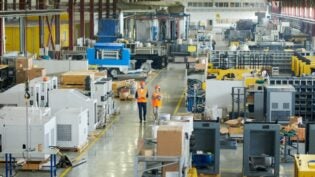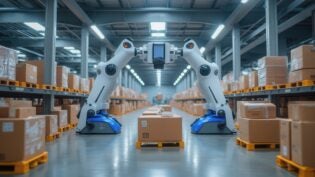13 Essential Pieces of Equipment for Manufacturing Companies
By: Victoria Hill

As a manufacturing company, you know that your employees are the backbone of your business. Their dedication to their work is what drives innovation and helps you achieve your goals in the marketplace. But to get the most out of your workers, you need to make sure they’re as comfortable and efficient as possible in their workspace. That’s where equipment comes in: it can help improve productivity and even create safer working conditions for employees.
1. Belt Conveyor Systems
Belt conveyors are useful in a variety of industrial applications, including manufacturing, warehousing, and distribution. Belt conveyors are used to move materials from one point to another by means of a continuous belt that moves from one pulley to another by means of rollers or wheels. They can be used for bulk materials or products, as well as enclosed transport systems. You can check out fluentconveyors.com for more information on belt conveyors.
2. Pneumatic Conveyors
A pneumatic conveyor is a system of tubes that can be used to move products across long distances or over short distances. They’re most often used in manufacturing, but they also work well for moving items around a warehouse or distribution center.
3. Custom Conveyors
Custom conveyors are a great choice for companies that need to move materials from one place to another. They are helpful when it comes to transporting goods around the manufacturing plant, as well as between different locations.
There are various types of custom conveyors available depending on the needs of your business. Some common options include:
- Chain conveyors – These are popular because they can be used in a variety of situations, including warehouses and distribution centers. They’re also relatively easy to install and maintain at a reasonable cost compared with other types of custom conveyor systems.
- Belt conveyors – This type is mostly used when transporting heavy loads over long distances or heights that need a more sturdy structure than what chains offer. While you do have more options for customization with belts (such as selecting belt material), these tend not to be found in smaller settings such as warehouses due their high cost relative.
4. Roller Conveyor Systems
Roller conveyors are used to transport items. They can be used for a variety of applications, and are available in a range of sizes.
Roller conveyors come in different styles and sizes, including small and large. The rollers themselves have been designed to prevent damage to the product being transported by absorbing shock. For this reason, roller conveyors can be used to transport heavy loads without risking damage or injury.
5. Chain Driven Conveyor Systems
Chain driven conveyors are a cost-effective way of transporting goods. They’re easy to install and maintain and require less maintenance than belt conveyors, which can reduce costs further. Chain driven conveyors are also quieter than belt driven systems and can be installed either above or below ground level without any additional structural work being required; this means that you’ll spend less time and money on installation, meaning that you’ll have more cash available for other projects in your factory.
6. Fill and Seal Machine
A fill and seal machine works like a shrink wrap machine, only it’s used to seal products that are already packaged. It heats a film or bag material and then presses it down onto the product, using heat to fuse the materials. The machine can also be used for packaging items such as cans or bottles.
Vertical form fill and seal machines can be used on many different types of materials—just make sure you know if they’re made for your specific use case! For example, some machines are designed specifically for sealing plastics while others cannot handle them at all (they will melt instead). When buying a fill and seal machine, you’ll want one that can handle most plastics as well as aluminum foil and paperboard (cardboard).
7. Insulation Blankets
Insulation blankets are a type of insulation used to keep heat in or out of space. They can be made of materials like plastic, wool, or cotton and used for many different purposes. Some common uses of removable insulation blankets include:
- Keeping moisture out of walls during construction
- Preventing condensation on pipes and ductwork
- Reducing noise levels in walls/floors (for soundproofing)
8. Pumps & Valves
Pumps and valves are essential pieces of equipment for manufacturing companies. Companies will need a lot of them from pumps and valve manufacturers. Pumps are used to move liquid or gas, while valves control the flow of liquid or gas. A pump is a device that moves fluids by creating pressure or suction within the fluid itself. A simple example would be an old-fashioned hand-operated pump where you press down on one end of a plastic tube to push water up through it into another container at the other end (the container). The greater force with which you press down on one end allows more water to be pulled up out of whatever reservoir you’re using as your source material—while also increasing how fast this happens!
9. Humidity Calibrator
A humidity calibrator is a device used to adjust the moisture level of your room, which can affect the quality of your products. For example, if you’re manufacturing something that requires strict quality control (like food or cosmetics), then you’ll want to make sure that the environment in which you’re manufacturing them is free from excess moisture. Humidity calibrators come with their sensors and display units, but they can also be connected to existing monitoring systems.
10. Pallet Handling Systems
Pallet handling systems are used to move pallets around the warehouse or factory floor. These types of equipment can include forklifts, conveyors, and other types of equipment. Pallet handling systems are used for many different purposes–some examples include loading/unloading trucks, keeping inventory in order on pallets so they can be easily retrieved when needed, storing merchandise until it’s ready to ship out or sold at a retail store, and much more!
The size of your business will determine what kind of pallet handling system(s) you need. If you have only a few employees working in a small office space with limited storage space available then investing in high-quality forklifts may not be feasible because they take up lots of room and require regular maintenance checks which means paying someone else (or yourself) more money every month just so that everything stays running smoothly.
11. Balers and Compactors
Balers and compactors are a great option for companies that need to store large amounts of scrap material. The equipment will compress the waste into bales (or cubes) that are easily stored and transported.
The first step in using a baler or compactor is to load the desired materials into the machine’s hopper. Then, you can set your preferred speed and compression level before initiating the process. The machine will begin compressing your materials, which you’ll be able to watch through its window as it progresses through its cycle. Once complete, all that remains is removing your bales from their place inside!
12. Shrink Wrappers and Stretch Wrappers
Shrink wrap is a plastic film that’s applied over pallets or containers to protect the product from damage. Stretch wrap is a plastic film that’s used to secure items together, often in conjunction with pallet racks.
13. Baggers and White Goods Conveyors
Bagging systems and white goods conveyors are used to transport items that cannot be transported through a roller conveyor system. Typically, these equipment pieces are seen in the food industry and medical industries, but they can be used anywhere there is a need to move bulk materials.
Conclusion
We hope this article has helped you understand the essential pieces of equipment that manufacturing companies need in order to operate efficiently. These machines help businesses move products from one place to another and can even save time and money, which is why we recommend investing in them today.
2435 Views












